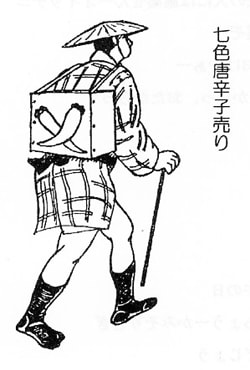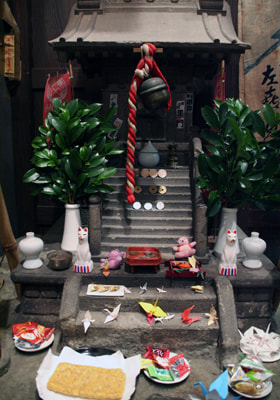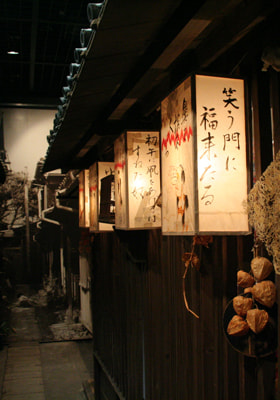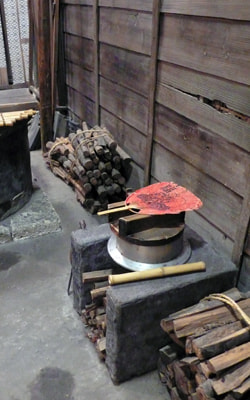Ishii: Street peddlers' cries vary from one locality to another, but street peddlers' cries in Tokyo are mainly played in the museum. Street peddlers used to come from various regions of the country. For example, street peddlers of "Magotaro-mushi" (folk medicine) came from Sendai. Many visitors mention "Roba no Pan-ya san."
Q: Street peddlers' cries can be still heard in Taito City. Are they fish peddlers? There are also Tofu peddlers.
Ishii: Now, Tofu peddlers get around with motorcycles, etc., but they use trumpets not only in the Shitamachi area but also in other areas. [continued in the upper right column]
Q: I think there was "Kiseru no Raoya," or tobacco pipe mender, in the early Showa Period.
Ishii: I think they existed in front of the Kaminari-mon gate until 30 to 40 years ago. Fairly large numbers of their photographs are preserved.[continued in the lower left column]

Street peddler "Nanairo spice peddler"

A bamboo blowpipe is put on the kitchen furnace.

A variety of offerings are place at the Inari shrine.

Q: You said that the row house scene on the first floor is set in the Taisho Period, but there are electric appliances. So it might be the Showa Period. The period is not specifically set, is it?
Ishii: One of the major points is the Kanto Great Earthquake. Among "electric appliances" displayed on the first floor, only electric lamp was widely used in the Taisho Period. The production periods of those household appliances vary. If you look at the transformation process of Tokyo, it turns out that there are three points: The Kanto Great Earthquake, war damage and redevelopment triggered by the Tokyo Olympic Games in 1964. Larger streets and buildings were constructed after each point, and lifestyles also changed. There have been movements which promote preservation of common people's culture in the Shitamachi area since around 1965. It was the time of high-rate economic growth. People who had a sense of crisis regarding the changes of townscapes, caused by unrestrained development, have carried out such movements - the term "unrestrained development" might be misunderstood.
The Tokyo Metropolitan Expressway was constructed and the Shinkansen, or Bullet Train, opened in time for the Tokyo Olympic Games, and trash boxes were taken away from streets, which affected many things. The changes of streets also changed lifestyles. The good old life in the Shitamachi area was going to be lost. Of course, it was the beginning of the time of large-scale production and consumption. In such a historical backdrop, there was a movement to preserve the good old life in a museum. When you look back the history of Tokyo while considering those trends, it turns out that Edo elements continued to exist before the Kanto Great Earthquake hit. It was a gradual modernization without large-scale destructions. However, the earthquake turned wide areas centering on Shitamachi into burned-out ruins. It is not an exaggeration to say that the areas were entirely transformed into a new city. Living spaces that existed before those changes are reproduced in this museum. [continued in the right column]
Q: Is there some kind of a criterion in this museum?
Ishii: The Kanto Great Earthquake comes first as a basis. The purpose is to preserve the Shitamachi area's townscape before the earthquake hit, which still had traces of Edo, and lifestyle in the area. If it goes back to the Edo Period, the period known by people who tried to open a museum at that time would be remote from it. Therefore, one of our intentions was to preserve the "period" which those people had known or experienced in their childhood. Also, as I mentioned before, one of the biggest turning points was the Tokyo Olympic Games in 1964. Electric products began to be widely used and lifestyles were significantly changed before the Olympic Games were held. Until then, people had used a fire to cook rice on traditional cooking stoves for several hundred years. This practice was replaced by electric rice cookers, which can cook rice with a single touch of a button. People had used their hands to wash clothes for several hundred or thousand years, but it was replaced by electric washing machines. Such products began to be a part of people's lives in the Shitamachi area. As for the townscape, row houses were demolished, and new buildings were constructed on the sites.
The exhibition on the first floor is based on the exhibition policy that people's lives before the earthquake hit should be passed down to future generations. The meanings and purposes of appliances, which were actually used, are indicated by placing them in living spaces as scene exhibitions. A living space in around 1955 is reproduced at a corner on the second floor, so visitors can compare it with those on the first floor. Also, visitors can not only see the actual appliances at that time but also touch them, so their textures and usabilities can be perceived. Moreover, things which do not have specific forms, such as seasonal or annual event, can be exhibited. The first Horse Day festival is currently exhibited. Since the lanterns with puns written on them are hung under the eaves of the row house and the Inari shrine is placed at the end of the alley, it can be discerned that it is a festival of Inari.[continued in the next page]

Street peddler "Nanairo spice peddler"

A bamboo blowpipe is put on the kitchen furnace.














